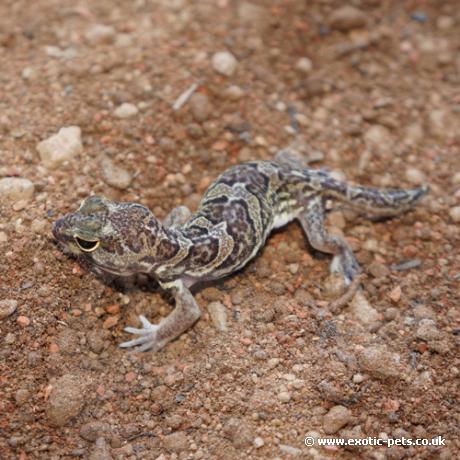

The African Clawed Gecko is a slow moving nocturnal species of lizard from the savannah areas of East Africa. They are smooth textured and nicely marked on the body.
The African Clawed Gecko is a small to medium sized gecko reaching an adult length of around 10-11cm. They have a typical gecko appearance, small head, short snout and large eyes with moveable eyelids. The tail is very short, measuring only 1cm; it is believed that this species will store fat reserves in the tail, therefore this can vary in thickness. They are lacking any enlarged toe pads due to being a terrestrial gecko and have claws present on each toe. The body texture is smooth and has a velvety appearance.
Colouration can vary from a rich chestnut to reddish-brown with cream to tan bands that run from the snout all the way down to the tail. These bands meet to form a mid-dorsal stripe that runs from the top of the head to the tip of the tail. The underside of the gecko is white or cream.
Sexing African Clawed Geckos is pretty straight forward, however females also have a slight swelling at the base of the tail; only the males have a clear bulge around cloaca area.
African Clawed Geckos are also known as Somali-Masai Clawed Geckos due to the area they were originally recorded from; Somali Horn in East Africa. Studies have since shown they have a wider area in Africa from Mandera and Malka Murris on the Kenya-Ethiopian boarder and South to the vicinity of Dodoma in central Tanzania.
They inhabit dry, sandy bush savannahs and semi deserts; found in damp burrows during the day due to being a nocturnal gecko.
This is an easy species to keep in captivity that does not require a large vivarium. To house a small breeding group of one male and two females, we would recommend housing them in a 36x18x18” vivarium or glass terrarium.
Providing a sandy soil or even a clay burrowing substrate will help this species dig burrows and hide during the daylight hours; the burrows are general humid and protect them from the heat. Placing rocks, caves and low branches will keep this gecko active during the night and allow rest area during the day.
Temperatures during the day generally reach around 27-30C (80.6-86F) throughout the year, therefore ensure a basking area of 28-30C (82.4-86F) with an ambient temperature of 24-26C (75.2-78.8F). Night temperature average between 15-18C (59-64.4F), therefore provide a reasonable drop at night to around 16-20C (60.8-68F).
The use of UVB is always recommend with all lizards, including nocturnal species; this can be either a strip tube or a compact bulb. We have been providing a 5% UVB strip within the enclosures with great success.
In the wild they are known to live in burrows near termite hills which they will eat after rain. Feed a varied diet of insects; dust the food with a vitamin supplement twice a week. Fresh water should be provided daily.